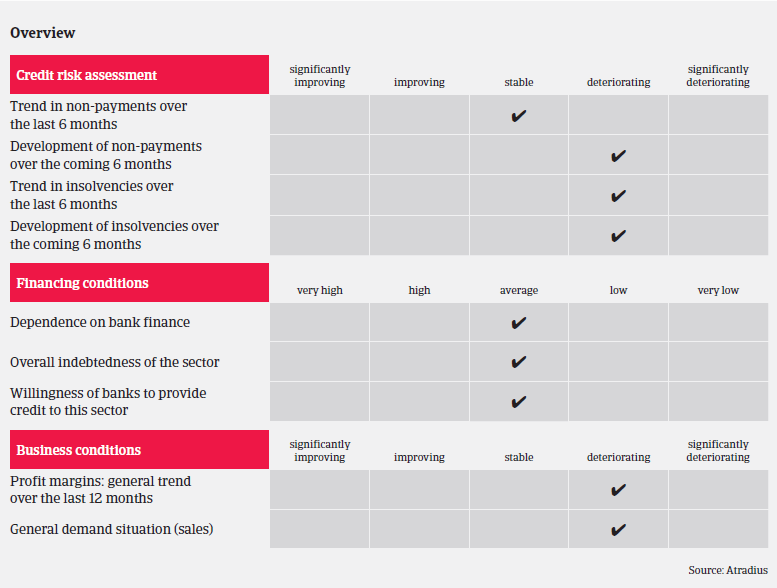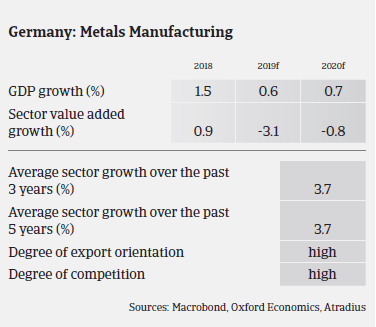Many businesses suffer from decreasing demand from key buyer sectors, high commodity prices, overcapacity, strong competition, and low profitability.
- Performance forecast downgrade due to mounting challenges
- More business failures expected in 2020
- Extension of payment terms ongoing


The German metals and steel sector is currently facing mounting challenges, which are seriously affecting the performance of many businesses in the industry. Ongoing global economic issues (Sino-US trade dispute, insecurity over the future EU-US trade relationship, Brexit, manufacturing slowdown in the EU and lower growth in China) are negatively affecting exports and domestic sales.
The US import tariffs on steel (25%) and aluminium (10%) have created additional problems. While the immediate impact is rather low (the US accounts for just 1.5% of German steel/aluminium exports), the German steel industry is suffering from lower steel prices, because of additional steel inflow redirected from the US into the EU. So far, the success of safeguarding and anti-dumping measures initiated by the European Commission in order to stem the flow of cheap steel imports has been limited.
While steel prices declined in 2019, transport, energy and labour costs have continued to increase for German businesses. There has been a truck driver shortage since 2018, and the situation could deteriorate in the coming years, potentially threatening the smooth supply flow along the value chain.
The automotive industry as one of the key buyer sectors for German metals and steel businesses is facing decreasing demand and fundamental structural challenges lay ahead (“Dieselgate”, Worldwide Harmonized Light Vehicles Test Procedure, shift away from combustion engines to e-mobility). For metals and steel component suppliers we have already noticed decreasing sales (down between 10% and 20%) and deteriorating results in H1 of 2019. Some suppliers have already implemented cost reduction measures (e.g. short-time work and redundancies) in order to cope with market uncertainty. Other businesses have issued profit warnings, or even started comprehensive restructuring processes.
Due to all those issues, we have recently downgraded the business performance and credit risk outlook for German metals and steel from “Fair” to “Poor”. Both segments suffer from decreasing demand from key buyer sectors (mainly automotive, but also mechanical engineering), high commodity prices (e.g. iron ore) which are difficult to pass on to customers, overcapacity, strong competition, low profitability and increased pressure on margins, which are expected to deteriorate further in the coming 12 months.
We have not yet noticed major changes in the payment behaviour of metals and steel businesses over the past couple of months. Payments take, on average, between 30 and 45 days. However, increasingly the trend of extending payment terms up to 60 days is noticeable. While the level of metal and steel business failures was low over the past twelve months, an increase of about 2%-3% is expected in H2 of 2019 and in 2020.
Our underwriting stance is mainly neutral to cautious for German steel and metal businesses. We have recently turned more cautious when underwritingWhile we are generally open for the iron and steel producer segment., Wwe are also more cautious with steel service centres, as. T this segment could see increased write-offs at the end of the fiscal year due to weak sales, well-stocked inventories and lower steel prices. Smaller steel traders often face strong competition and low margins; especially those without additional business like prefabrication.
In the metals segment we remain mainly neutral for smaller and medium-sized wholesalers, which often show low equity and tight margins. We have tightened our underwriting stance on metal manufacturing, especially on those businesses that depend heavily on sales to the automotive sector. Many companies in this segment have a weak solvency and equity position. Pressure on their margins is already high, and they have to make additional investments to adapt to the changing market environment (e.g. e-mobility). We focus on liquidity, profitability and the order situation as well as the individual business outlook.

Documentos relacionados

1.06MB PDF
